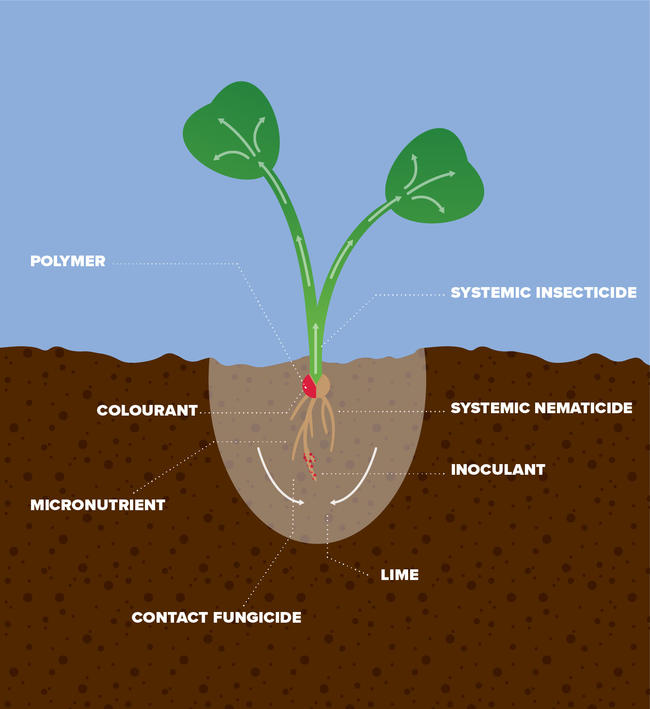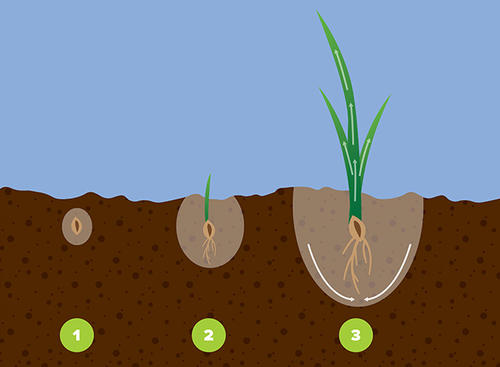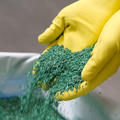The seed treatment formulations developed by PGG Wrightson Seeds Limited contain additives that are unique to the seed type and/or end use. These additives combine to provide a better environment for seedling establishment and early growth. Most products contain a systemic insecticide, with at least one contact fungicide, along with other beneficial additives including micronutrients.

POLYMER
Binds active ingredients and other additives to the seed to ensure precise coverage and minimise dust emissions, which in turn protects applicators, end users and the environment.
COLOURANT
Identifies that seed has been treated, while also helping to deter birds from consuming surface applied seed, with green and blue colourants proven to be the most effective.
MICRONUTRIENT
Applying molybdenum to seed is a cost-effective way of ensuring seedlings have a start-up supply of this important micronutrient, which is required for plant growth and root nodulation in legumes.
CONTACT FUNGICIDE
Protects seedlings from common seed and soil-borne fungal pathogens. Young seedlings are most susceptible to disease infection during establishment, particularly those under environmental stress.
SYSTEMIC INSECTICIDE
Protects seedlings when they are most vulnerable to insect pressure. The insecticides are target specific against economically damaging foliar and root feeding insect pests.
SYSTEMIC NEMATICIDE
Protects the root zone of clover seedlings from soil-dwelling nematodes during establishment.
INOCULANT
The clover and lucerne seed treatments contain rhizobia strains specific to these seed types.
LIME
The application of fine lime in legume seed treatment can provide a localised increase in soil pH around the seedling, assisting root nodulation. Lime also benefits aerial oversowing with the added weight improving seed ballistics.
It should be noted that while each specific seed treatment contains a range of additives, none of the seed treatment products contain all of the additives featured in the graphic above.
INSECTICIDE
Insecticides included in seed treatment products are typically systemic in terms of their transmission, where chemical active ingredient is taken up by the young roots and distributed throughout the developing plant. Seedlings are protected during the first six weeks of establishment to the point where plants are in a much better position to withstand pest attack.
Systemic insecticides offer a very effective mode of action, providing both anti-feeding and knock down effects against target insects, protecting the plant above and below ground (see diagram below).
It is important to note that some pests such as Slugs and Black Field Crickets, will not be controlled by seed treatments, hence the need to incorporate other forms of pest control into the reseeding programme. Also,
when a target pest population is high (e.g. Springtail), an additional form of pest control such as a foliar applied insecticide may be required to support the protection provided by seed treatment.

MODE OF ACTION
- Chemical active ingredient is gradually released into the soil after the seed is sown, forming a protective barrier around the seed.
- Plant absorbs active ingredient through the young roots. Targeted soil pests will either be deterred or knocked down if chemical is ingested.
- Active ingredient is transported to developing foliage and is uniformly distributed in plant tissues. Foliar insect pests are quickly knocked down when they ingest plant matter.
FUNGICIDE
The fungicides in seed treatment products use contact transmission to protect seedlings in the first three to four weeks of establishment. The importance of fungicide protection is often undervalued, with plant damage in many situations incorrectly identified as another factor, such as nutrient deficiency or insect attack. Fungicides are beneficial when planting into cool or damp soils, since these conditions may increase the risk of fungal attack or delay the speed of germination. When germination is delayed through soil moisture deficiency, the seed will remain protected by fungicide until it germinates.
Fungicides provide a knock down form of protection during early seedling growth. Chemical active ingredient is released into the soil after the seed germinates, protecting developing roots against soil-borne fungal pathogens. The active ingredient is also effective against fungal pathogens that are present on the seed.




